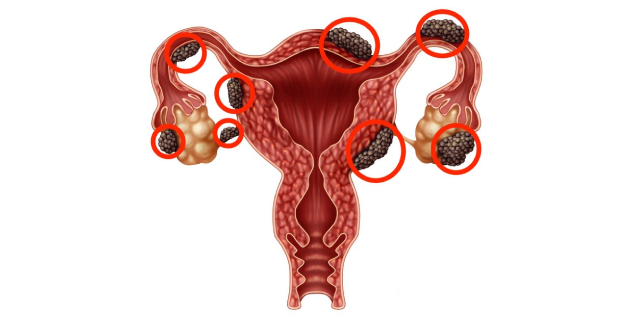
This disorder is considered as an enigma to diagnose and treat.
What is Endometriosis?
Endometriosis is a painful disorder in which tissue similar to the tissue that normally lines the inside of your uterus called the endometrium grows outside your uterus. Endometriosis most commonly involves your ovaries, fallopian tubes and the tissue lining your pelvis. Rarely, endometrial tissue may spread beyond pelvic organs.
In a regular menstrual cycle, the endometrium sheds of in every cycle and a fresh endometrium is formed. Similarly, endometrium deposited outside the uterus breaks down and bleeds with each menstrual cycle. Surrounding tissue becomes irritated, eventually developing scar tissue and adhesions (abnormal bands of fibrous tissue) that can cause pelvic tissues and organs to stick to each other. When endometriosis involves the ovaries, there are chances of formation of cysts called endometriomas.
Classic studies have suggested that 25 to 50% of infertile women have endometriosis and 30-50% of women with endometriosis are infertile. Endometriosis is found in 45% - 82% of women with chronic pelvic pain. Nevertheless, its prevalence depends on patient profile and diagnostic tools utilized. However, its prevalence is 6-21 times higher in infertile as opposed to fertile women.
Common signs and symptoms of endometriosis include:
- Painful periods (dysmenorrhea)- Pelvic pain and cramping may begin before and extend several days into a menstrual period. You may also have lower back and abdominal pain.
- Pain with intercourse- Pain during or after sex is common with endometriosis.
- Pain with bowel movements or urination - You're most likely to experience these symptoms during a menstrual period.
- Excessive bleeding - You may experience occasional heavy menstrual periods or bleeding between periods (intermenstrual bleeding).
- Infertility - Sometimes, endometriosis is first diagnosed in those seeking treatment for infertility.
- Other signs and symptoms - You may experience fatigue, diarrhea, constipation, bloating or nausea, especially during menstrual periods.
The severity of your pain isn't necessarily a reliable indicator of the extent of the condition. You could have mild endometriosis with severe pain, or you could have advanced endometriosis with little or no pain.
- History
- Ultrasound : Persistent ovarian cysts are suggestive of endometriosis.
- MRI : Ovarian cysts/Peritoneal or other structural involment can be diagnosed
- Laparoscopy : Gold standard for the diagnosis and treatment
Diagnosis
Inability to conceive is one of the complains in endometriosis. The various ways of which endometriosis causes difficulty in conception
- Difficulty in consummation of marriage
- Ectopic endometrial tissue if found on fallopian tubes damages it resulting in obstruction or unhealthy tubes. It may result in changes in anatomy and relationship of tubes with ovary.
- Ectopic endometrial tissue on the ovary can results in cyst formation which affects ovarian reserve resulting in reduction in quantity as well as quality of the oocyte (egg)
- Ectopic endometrial tissue in the peritoneal area results in inflammatory markers raised which is known to cause an unhealthy environment for egg quality and sperm survival.
Even so, many with mild to moderate endometriosis can still conceive and carry a pregnancy to term. It is advisable that those with endometriosis not to delay having children because the condition may worsen with time.
Treatment
Is decided by the treating doctor depending on symptoms, age of the patient and severity of disease.
